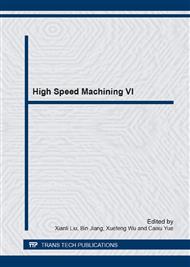[1]
Man X L, Ren D Y, Usui S, Johnson C and Marusich T D. Validation of finite element cutting force prediction for end milling. Procedia CIRP, 1 (2012) 663-668.
DOI: 10.1016/j.procir.2012.05.019
Google Scholar
[2]
Nalbant M, Altın A and Gökkaya H. The effect of cutting speed and cutting tool geometry on machinability properties of nickel-base Inconel 718 super alloys. Materials and Design, 28. 4 (2007) 1334-1338.
DOI: 10.1016/j.matdes.2005.12.008
Google Scholar
[3]
Pal P P, Prabhu R V and Sakthimurugan K. Surface error compensation in HSM of thin wall structures. International Journal of Engineering Science Invention, 2. 2 (2013) 1-11.
Google Scholar
[4]
Saglam H, Yaldiz S and Unsacar F. The effect of tool geometry and cutting speed on main cutting force and tool tip temperature. Materials and Design, 28. 1 (2007) 101-111.
DOI: 10.1016/j.matdes.2005.05.015
Google Scholar
[5]
Saglam H, Unsacar F and Yaldiz S. Investigation of the effect of rake angle and approaching angle on main cutting force and tool tip temperature. International Journal of Machine Tools and Manufacture, 46. 2 (2006) 132-141.
DOI: 10.1016/j.ijmachtools.2005.05.002
Google Scholar
[6]
Shih A J. Finite element analysis of the rake angle effects in orthogonal metal cutting. International Journal of Mechanical Science. 38. 1 (1995) 1-17.
DOI: 10.1016/0020-7403(95)00036-w
Google Scholar
[7]
Zhang L and Zheng L. Prediction of cutting forces in end milling of pockets. The International Journal of Advanced Manufacturing Technology, 25. 3-4 (2005) 281-287.
DOI: 10.1007/s00170-003-1841-5
Google Scholar
[8]
Zhang L and Zheng L. Prediction of cutting forces in milling of circular corner profiles. International Journal of Machine Tools and Manufacture, 44. 2 (2004) 225-235.
DOI: 10.1016/j.ijmachtools.2003.10.007
Google Scholar
[9]
Wu B H, Yan X, Luo M and Gao G. Cutting Force Prediction for Circular End Milling Process. Chinese Journal of Aeronautics, 26. 4 (2013) 1057-1063.
DOI: 10.1016/j.cja.2013.04.003
Google Scholar
[10]
Abdullah R I R. Hybrid deflection prediction for machining thin-wall titanium alloy aerospace component. Melbourne: Royal Melbourne Institute of Technology University, (2011).
Google Scholar
[11]
Budak E, Altintas Y. Modeling and avoidance of static form errors in peripheral milling of plates[J]. International Journal of Machine Tools and Manufacture, 1995, 35(3): 459-476.
DOI: 10.1016/0890-6955(94)p2628-s
Google Scholar


